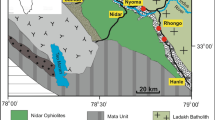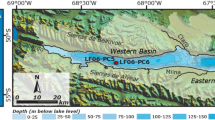Abstract
In the present work, we investigate the iron oxides and oxyhydroxides behavior and evolution, related to the geochemical behavior of some metals, which could be retained as solid phases in the sediments from an urban water reservoir lake, placed in Taiaçupeba, Great São Paulo, Brazil. These tasks were performed by the establishment of a proceduring setting for environmental monitoring analysis through Mössbauer spectroscopy measurements associated to hysteresis loops measurements and chemical analysis [X-ray fluorescence (XRF)]. We inferred the possibility of goethite occurrence in broad particle size distribution (5–50 nm), and related to ferrihydrite, and small grain-size hematite (about 8 nm). The magnetometry results pointed to the paramagnetic/superparamagnetic behavior of the magnetic phases present in the samples and also suggested the occurrence of small grain-size magnetite. We also verified the presence of clay minerals related to Fe, as well as the occurrence of Fe3+ and/or Fe2+ in short-range structural order. Through a straight correlation among Mössbauer spectra data gained at T = 77 K and Al-metal, metal-Fe molar ratios, provided through XRF data, we found remarkable indications of interference on meta-stable phases evolution to its final products. Such results can be pointing for evidences about the possible isomorphic replacing and/or adsorption of Al and other metals in goethite and hematite.






Similar content being viewed by others
References
Benali O, Abdelmoula M, Refait P, Génin J-MR (2001) Effect of orthophosphate on the oxidation products of Fe(II)-Fe(III) hydroxycarbonate: the transformation of green rust to ferrihydrite. Geochem Cosmochim Acta 65(11):1715–1726
Bishop JL, Lougear A, Newton J, Doran PT, Froeschl H, Trautwein AX, Körner W, Koeberl C (2001) Mineralogical and geochemical analyses of Antartic lake sediments: a study of reflectance and Mössbauer spectroscopy and C, N, and S isotopes with applications for remote sensing on Mars. Geochem Cosmochim Acta 65(17):2875–2897
Blowes DW, Ptacek CJ, Benner SG, McRae CWT, Bennett TA, Puls RW (2000) Treatment of inorganic contaminants using permeable reactive barriers. J Contam Hydrol 45:123–137
Blot A, Imbernon RAL (2000) Caractérization par analyse thermique de la constitution cristallochimique de diverses chlorite zincifères. C R Acad Sci Paris Ser I 330:469–472
Borgmann U, Néron R, Norwood WP (2001) Quantification of bioavailable nickel in sediments and toxic thresholds to Hyalella azteca. Env Polit 111:189–198
Bowen LH, De Grave E, Vandenberghe RE (1993) Mössbauer effect studies of magnetic soils and sediments. In: Long GJ, Grandjean F (eds) Mössbauer spectroscopy applied to magnetism and materials science, vol 1. Plenun Press, New York, pp 115–159
Braga BPF, Porto MFA, Silva RT (2006) Water management in metropolitan São Paulo. Int J Water Res Dev 22(2):337–352
Brand RA (1987) Improving the validity of hiperfine field distributions from magnetic alloys—Part I: unpolarized source. Nucl Instrum Methods B 28:398–416
Cornell RM, Schewertmann U (1996) The iron oxides—structure, properties, reactions, occurrence and uses. Weinhein, New York, pp 573
Childs CW, Baker-Sherman JG (1984) N.Z. soil bureau scientific report 66, Department of Science and Industrial Research. Lower Hutt, New Zealand, pp 50
Dauvalter V, Rognerud S (2001) Heavy metal pollution in sediments of the Pasvik river drainage. Chemosphere 42(1):9–18
Davis AP, Upadhyaya M (1996) Desorption of cadmium from goethite (α-FeOOH). Water Res 30(8):1894–1904
De Grave E, Bowen LH, Vochten R, Vandenberghe RE (1988) The effect of crystallinity and Al substitution on the magnetic structure and Morin transition in hematite. J Magn Magn Mater 72:141–151
Dong D, Li Y, Zhang B, Hua X, Yue B (2001) Selective chemical extraction and separation of Mn, Fe oxides and organic material in natural surface coatings: application to the study of trace metal adsorption mechanism in aquatic environments. Microchem J 69:89–94
Drodt M, Trautwein AX, König I, Suess E, Bender Koch C (1997) Mössbauer spectroscopy studies on the iron forms of deep-sea sediments. Phys Chem Miner 24:281–293
Dunn PJ, Peacor DR, Ramik RA, Shu-Chun S, Rouse RC (1987) Franklinfurnaceite, a Ca-Fe3+-Mn3+-Mn2+ zincosilicate isotypic with chlorite, from Franklin, NJ. Am Miner 72:812–815
Enzweiler J, Vendemiatto MA (2004) Analysis of sediments and soils by X-ray fluorescence spectrometry using matrix corrections based on fundamental parameters. Geostand Geoanal Res 28:103–112
Förstner U, Schoer J, Knauth HD (1990) Metal pollution in the tidal Elbe river. Sci Total Environ 97/98:347–368
Ford RG, Kemner KM, Bertsch PM (1999) Influence of sorbate-sorbent interactions on the crystallization kinetcs of nickel—and lead—ferrihydrite coprecipitates. Geochim Cosmochim Acta 63:39–48
Franco DR (2002) Caracterização Magnética e Estrutural das Fases de Ferro em Sedimentos da Barragem de Taiaçupeba, São Paulo. MSc, University of São Paulo, Brazil (in Portuguese)
Gálvez N, Barrón V, Torrent J (1999a) Effect of phosphate on the crystallization of hematite, goethite and lepidocrocite from ferrihydrite. Clays Clay Miner 47(3):304–311
Gálvez N, Barrón V, Torrent J (1999b) Preparation and properties of hematite with structural phosphorus. Clays Clay Miner 47(3):375–385
Guodong Z, Takano B, Kuno A, Matsuo M (2001) Iron speciation in modern sediment from Erhai Lake, southwestern China—Redox conditions in an ancient environment. Appl Geochem 16:1201–1213
Imbernon RAL, Oliveira SMB, Blot A, Magat P (1999) Os chapéus de ferro associados ao depósito de Pb-Zn-Ag na região de Canoas, Adrianópolis (PR)—Evolução geoquímica e mineralógica. Geochim Brasil 13(2):145–161
Liang L, Korte N, Gu B, Puls R, Reeterd C (2000) Geochemical and microbial reactions affecting the long-term performance of in situ iron barriers. Adv Environ Res 4:273–286
Mitra S (1992) Applied Mössbauer spectroscopy—theory and practice for geochemists and archaeologists. Pergamon Press, Oxford, pp 381
Murad E (1998) Clays and clay minerals: what can Mössbauer spectroscopy to do help understand them? Hypn Interact 117:39–70
Murad E, Schwertmann U (1980) The Mössbauer spectrum of ferrihydrite and its relations to those of other iron oxides. Am Miner 65:1044–1049
Oliveira SMB, Imbernon RAL, Partiti CSM, Rechenberg HR (1996) Mössbauer spectroscopy study of iron oxides and oxyhydroxides in gossans. Geoderma 73:245–256
Petrovsky E, Ellwood BB (1999) Magnetic monitoring of air-, land- and water pollution. In: Maher BA, Thompson R (eds) Quaternary climates, environments and magnetism. Cambridge University Press, Cambridge, pp 279–322
Trivedi P, Axe L, Dyer J (2001) Adsorption of metal ions onto goethite: single-adsorbate and competitive systems. Colloids Surf A Physiochem Eng Aspen 191(1–2):107–121
Van der Zee C, Slomp CP, Rancourt DG, de Lange GJ, Van Raaphorst W (2005) A Mössbauer spectroscopic study of the iron redox transition in eastern Mediterranean sediments. Geochim Cosmochim Acta 69:441–453
Vandenberghe RE, De Grave E, Landuydt C, Bowen LH (1990) Some aspects concerning the characterization of iron oxides and hydroxides in soils and clays. Hypn Interact 53:175–195
Acknowledgments
The authors are grateful to Prof. Dr. G. F. Goya, Prof. Dr. H. R. Rechenberg, Dr. J. A. H. Coaquira and Renato Cohen (Institute of Physics, University of São Paulo, Brazil) for the valuable contributions, which allowed the development of the present study. This work was partly supported by the Brazilian agencies CNPq and FAPESP (grants 00/06066-3 and 02/06480-0).
Author information
Authors and Affiliations
Corresponding author
Rights and permissions
About this article
Cite this article
Franco, D.R., Berquó, T.S., Imbernon, R.A.L. et al. Environmental monitoring of magnetic iron phases of urban water reservoir lake sediments (Taiaçupeba Lake, metropolitan region of São Paulo, Brazil) by using Mössbauer spectroscopy. Environ Geol 52, 831–842 (2007). https://doi.org/10.1007/s00254-006-0525-5
Received:
Accepted:
Published:
Issue Date:
DOI: https://doi.org/10.1007/s00254-006-0525-5




